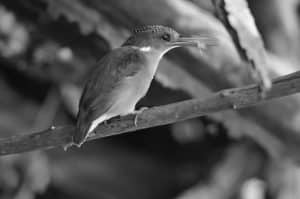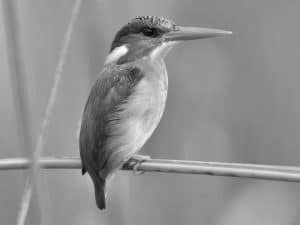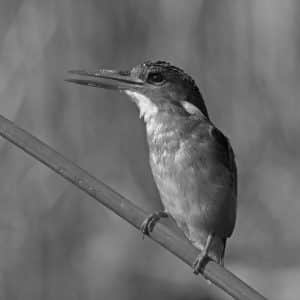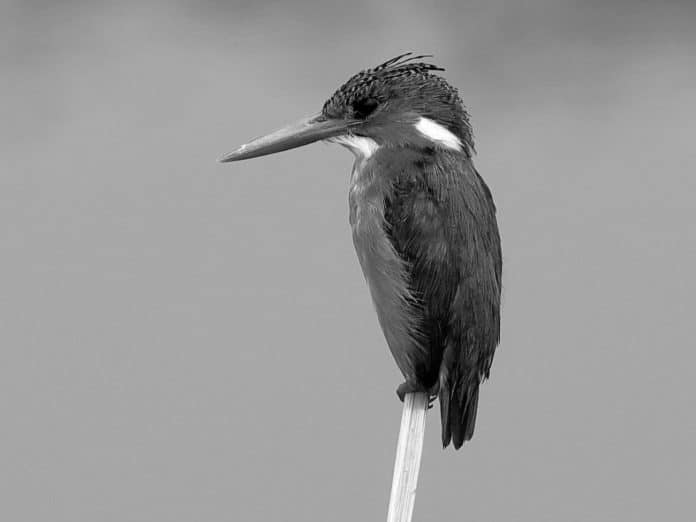Introduction to the Malachite Kingfisher in Tanzania
Welcome to the stunning world of the Malachite Kingfisher in Tanzania. With its vibrant colors and graceful presence, the Malachite Kingfisher is a true gem of East Africa. Found along the lakeshores of Tanzania, this small but striking bird captivates the hearts of birdwatchers and nature enthusiasts alike. In this article, we will delve into the habitat, behavior, importance, conservation efforts, and cultural significance of the Malachite Kingfisher in Tanzania. Get ready to embark on a journey through the lush landscapes and shimmering waters where these magnificent creatures thrive.

The Malachite Kingfisher, scientifically known as Corythornis cristatus, is a compact and colorful bird species that graces the lakeshores of Tanzania with its presence. Measuring around 13 to 14 centimeters in length, it may be small in size, but its vivid plumage and distinctive features make it a standout character in the avian world. The upperparts of the Malachite Kingfisher are adorned with rich, deep blue-green feathers, which blend seamlessly with the iridescent turquoise tones that adorn its wings and tail. Its underparts boast a warm chestnut hue, accentuated by a brilliant orange throat and breast. The combination of these striking colors makes the Malachite Kingfisher a sight to behold, especially when it takes flight over the tranquil waters of Tanzanian lakeshores.
Habitat and Behavior of the Malachite Kingfisher
The Malachite Kingfisher is predominantly found in the lush, verdant habitats surrounding lakes, rivers, and other bodies of freshwater. In Tanzania, these charming birds are often spotted along the shores of iconic lakes such as Lake Victoria, Lake Tanganyika, and Lake Malawi. With their preference for densely vegetated areas near water, Malachite Kingfishers can be observed perched on overhanging branches, reeds, or other vantage points where they patiently await their next meal. Their diet primarily consists of small fish, aquatic insects, and even tadpoles, which they skillfully hunt by plunging into the water from their elevated perches.
During the breeding season, the Malachite Kingfisher displays fascinating courtship behaviors, with the male engaging in aerial displays and offering fish to the female as part of their mating rituals. Once a suitable nesting site is chosen, often a burrow in the riverbank or a hollow in a termite mound, the female lays a clutch of eggs, which both parents take turns incubating. The nurturing and protective nature of these birds during the breeding period showcases their dedication to ensuring the survival of their offspring, further emphasizing their significance in the delicate ecosystems of Tanzanian lakeshores.
The Importance of Tanzanian Lakeshores for Malachite Kingfishers
Tanzanian lakeshores play a crucial role in providing essential habitats for the Malachite Kingfishers. The abundance of freshwater resources, coupled with the diverse array of flora and fauna that thrive in these aquatic environments, creates a haven for these captivating birds. The intricate network of interconnected ecosystems along the lakeshores supports a complex web of life, where the presence of Malachite Kingfishers contributes to the balance and biodiversity of the region.
As prolific hunters, Malachite Kingfishers help regulate populations of small fish and aquatic invertebrates, playing a vital role in maintaining the ecological equilibrium of their habitats. Furthermore, their striking presence adds to the allure of Tanzanian lakeshores, attracting visitors and nature enthusiasts from around the world. The captivating sight of a Malachite Kingfisher perched on a swaying reed or gracefully skimming the water’s surface in search of prey enhances the overall appeal of these picturesque landscapes.
Conservation Efforts for Malachite Kingfishers in Tanzania
Recognizing the significance of preserving the natural habitats of Malachite Kingfishers, conservation efforts in Tanzania are focused on safeguarding the lakeshores and the surrounding ecosystems. Conservation organizations and local communities are working together to address the challenges and threats faced by these avian gems. The degradation of wetlands, pollution, and habitat loss due to human activities are among the primary concerns that conservation initiatives aim to mitigate.
Through habitat restoration projects, community engagement, and educational programs, efforts are being made to raise awareness about the importance of conserving the habitats that sustain the Malachite Kingfisher populations. By promoting sustainable practices and fostering a deeper understanding of the interconnectedness between human activities and the well-being of these avian treasures, conservationists strive to secure a brighter future for the Malachite Kingfishers and the ecosystems they inhabit.
Birdwatching Opportunities for Malachite Kingfishers in Tanzania

For avid birdwatchers and nature enthusiasts, Tanzania offers unparalleled opportunities to observe Malachite Kingfishers in their natural habitats. The lakeshores provide ideal settings for birdwatching excursions, where visitors can witness these stunning birds in action. Whether it’s the tranquil shores of Lake Victoria, the crystal-clear waters of Lake Tanganyika, or the breathtaking vistas of Lake Malawi, each location presents unique experiences for observing the captivating behaviors of Malachite Kingfishers.
Guided birdwatching tours and eco-friendly boat trips allow visitors to explore the diverse ecosystems along Tanzanian lakeshores while keeping a lookout for these enchanting birds. The peaceful ambiance and natural beauty of the surroundings create a serene backdrop for observing Malachite Kingfishers as they dive, fish, and display their vibrant plumage. With the guidance of experienced naturalists and local guides, birdwatching enthusiasts can gain valuable insights into the behaviors and habitats of Malachite Kingfishers, enhancing their appreciation for these remarkable avian treasures.
Tips for Spotting Malachite Kingfishers in Tanzanian Lakeshores
Spotting Malachite Kingfishers amidst the picturesque landscapes of Tanzanian lakeshores requires patience, keen observation, and an understanding of their preferred habitats and behaviors. To increase the chances of encountering these captivating birds, consider the following tips for spotting Malachite Kingfishers in their natural environments.
First, familiarize yourself with the typical habitats of Malachite Kingfishers, which include areas with overhanging vegetation near water bodies. Look for reeds, bushes, or low-hanging branches where these birds are known to perch while hunting for prey. Once you have identified suitable locations, maintain a respectful distance and use binoculars or a spotting scope to scan the surroundings carefully.
Early morning and late afternoon are often prime times for birdwatching, as Malachite Kingfishers may be more active during these periods. Be mindful of minimizing disturbances and avoiding sudden movements that could startle the birds. By remaining inconspicuous and respecting their natural behaviors, you can increase the likelihood of observing Malachite Kingfishers as they go about their daily activities along the tranquil lakeshores of Tanzania.
The Role of Malachite Kingfishers in the Ecosystem
The Malachite Kingfisher plays a multifaceted role in the intricate tapestry of ecosystems found along Tanzanian lakeshores. As skilled hunters, these birds contribute to the regulation of fish and invertebrate populations, helping to maintain the ecological balance of their habitats. By preying on small fish and aquatic insects, Malachite Kingfishers play a part in controlling the abundance of these organisms, preventing unchecked population growth that could disrupt the delicate equilibrium of the aquatic ecosystems.
Furthermore, the presence of Malachite Kingfishers adds to the overall biodiversity and aesthetic appeal of Tanzanian lakeshores. Their striking plumage, graceful flight, and distinctive calls enrich the natural tapestry of the region, enhancing the allure of these scenic landscapes. As indicators of environmental health, the well-being of Malachite Kingfisher populations serves as a barometer for the overall ecological integrity of the lakeshores, making them valuable ambassadors for the preservation of these vital habitats.
Challenges Facing Malachite Kingfishers in Tanzanian Lakeshores

Despite their inherent resilience, Malachite Kingfishers face a range of challenges in the ever-changing landscapes of Tanzanian lakeshores. Habitat degradation due to urbanization, agricultural expansion, and deforestation poses a significant threat to the natural habitats that sustain these birds. The loss of suitable nesting sites, pollution of freshwater resources, and disturbances from human activities further compound the challenges faced by Malachite Kingfishers in their quest for survival.
Climate change also presents a formidable obstacle, as alterations in weather patterns and the availability of prey species can impact the reproductive success and overall well-being of Malachite Kingfishers. The interconnected nature of these challenges underscores the importance of taking comprehensive and coordinated actions to address the complex array of threats facing these avian gems. By addressing the root causes of habitat degradation, promoting sustainable practices, and fostering a deeper understanding of the delicate balance within these ecosystems, efforts can be made to mitigate the challenges confronting Malachite Kingfishers in Tanzanian lakeshores.
The Cultural Significance of Malachite Kingfishers in Tanzania
In addition to their ecological importance, Malachite Kingfishers hold cultural significance in Tanzania, where they are revered for their beauty and symbolism. These charming birds have inspired local folklore and traditions, with their vibrant plumage and graceful presence becoming intertwined with cultural narratives and artistic expressions. Their association with freshwater ecosystems and the tranquility of lakeshores has led to their portrayal in indigenous stories, where they symbolize harmony, abundance, and the interconnectedness of nature.
Furthermore, the allure of Malachite Kingfishers has transcended cultural boundaries, capturing the imagination of people from diverse backgrounds. Through their captivating displays of aerial agility and their melodic calls that resonate across the lakeshores, Malachite Kingfishers have become emblematic of the natural splendor that defines Tanzania’s aquatic landscapes. Their presence serves as a source of inspiration for conservation efforts and a reminder of the intrinsic value of preserving the rich cultural and ecological tapestries that encompass these avian treasures.
Conclusion
As we conclude our exploration of the Malachite Kingfisher’s presence along Tanzanian lakeshores, it is evident that these enchanting birds embody the delicate interplay between ecological significance and cultural symbolism. Their vibrant plumage, graceful behaviors, and pivotal role in maintaining the balance of freshwater ecosystems underscore the importance of safeguarding the habitats that sustain them. To ensure the continued thriving of Malachite Kingfishers in Tanzania, it is imperative for individuals, communities, and organizations to take proactive steps in conservation and preservation efforts.

































